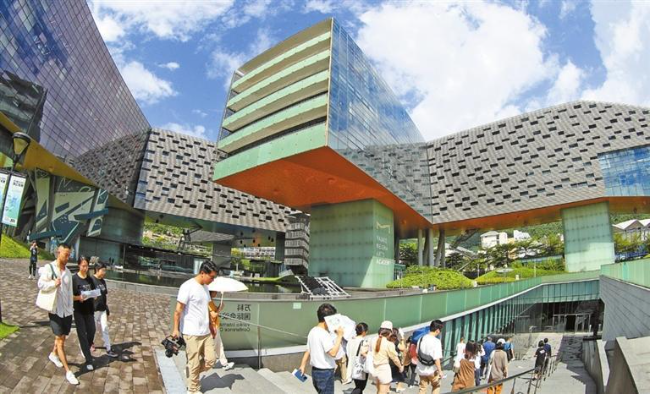Dameisha, a living lab of zero carbon community
2023-07-10

A view of the center
ALMOST every day after school, especially at weekends, Chen Yu’an, a primary school student in Meisha Sudistrict, Dameisha Community in Yantian District, often finds happiness and satisfies his curiosity by venturing into nature to watch birds in the forest, catch fish in Meisha River, or watch insects at night together with his family.
Chen even made a bird-watching guide map with photos of over 30 bird species that he has observed.
“Activities interacting with nature fascinate me and open a new world for me,” Chen said while sharing his “My Meisha World” stories at a workshop during Open Day organized by Vanke Foundation on Tuesday.
On the day, citizens were invited to explore the Meisha Carbon-neutral Community, which is piloting green and low-carbon development.
Help from flies
The trip started from the Black Soldier Fly House at the Vanke Center, which is also known as a horizontal skyscraper and one of the most sustainable mixed-use buildings in the world that achieved LEED (leadership in energy and environmental design) Platinum certification in 2011.
When you step into the 70-square-meter house near a kitchen of the center, you will find the kitchen leftovers are treated in an unusual way.
After assorting, drying and grinding, the kitchen waste becomes food for black soldier flies, which can consume around 200 kg a day, equivalent to reducing 64.5 metric tons of carbon emissions a year.
The station treats all the kitchen waste from the center’s three canteens, and it is a complete ecological system where the flies’ larvae is used as food for fish in the tanks.
“Black soldier fly larvae can consume kitchen waste 200,000 times their weight in their 7 to 9-day growth. During their 25-day life cycle, these flies can produce antimicrobial agents — making them a good source of protein for fish or animal feed,” Du Juan, project manager of Vanke Foundation, said.
So far, the program has been expanded across Meisha, with the establishment of the city’s first zero carbon science museum nearby, which can handle 3 metric tons of kitchen waste through black solider flies each day.
Rooftop energy
The second stop was the center’s rooftop, where the larvae’s excrement is used as a fertilizer for flowers and vegetable. The roof is also installed with 8,000 sqm solar panels.
It is not only a place that provides shelter for birds and insects, but also an area for farming and ecological education. It has also helped reduce energy consumption via photovoltaic power, application of energy-saving materials and intelligent power technologies.
“The use of green electricity at the center, or 720,000 kWh a year, has reached 85% of the total electric consumption of the center,” said Xie Xiaohui, secretary general of Vanke Foundation.
Low-carbon community
In 2021, Dameisha Community was chosen as one of the three communities in Shenzhen to pilot the near-zero emission program. Vanke Foundation signed a deal that year with the Yantian government to turn the community into a demonstration area for carbon neutrality.
Last year, the community was used as a typical example of China’s efforts in ecological conservation at the 27th Conference of the Parties of the U.N. Framework Convention on Climate Change (COP27) in Egypt.
According to Yu Kai with the Meisha Subdistrict Office, the subdistrict has built zero waste full scenario applications at all three-star hotels and 25 housing compounds. (Shenzhen Daily)
